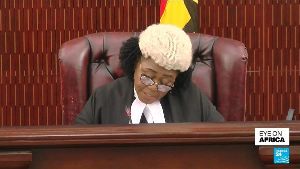Dedicated To The Okyenhene: Osagyefo Nana Amoatia Ofori-Panin
I. ABSTRACT
Most pundits widely describe the Chernobyl accident as a turning point for the nuclear power industry worldwide. According to World Association of Nuclear Operators (WANO), “it demonstrated clearly that nuclear power in some parts of the world was indeed, not safe enough.” In this context, they appear to be on spot when they assert that if anything, the 21 century has intensified concerns about the threat of nuclear proliferation and the spread of weapons of mass destruction. As Darryl Howlett, an international relations theorist reminds us, “the bombings of the Japanese cities of Hiroshima and Nagasaki at the close of Second World War ((6 & 9 August 1945)) and the explosion that wrecked civil nuclear plant at Chernobyl in the former Soviet Union, in 1986, illuminated not only the devastating effects of nuclear radiation. But also the glaring potential for long-term environmental damage across territorial frontiers when carried on the prevailing winds. ” So, in the midst of desperations, anxieties and indeed expectations, what does the future hold for Ghana’s nuclear programme?
II. INTRODUCTION
This paper intends not to frustrate, discourage or to thwart the efforts of the government’s desperate attempt to find a lasting-solution to our long-overdue energy needs. It seeks rather, to highlight the known dangers of nuclear proliferation to even most advanced countries and the way forward in our renewed bid to nuclear stations as sources of energy generation. Thus, almost all nuclear weapons states we know or suspect of having nuclear weapon ambitions, began or were motivated under the pretext of President Eisenhower’s ‘Atoms for Peace’ speech on 8 December 1953 which ignited the creation of the International Atomic Energy Agency (IAEA) in 1956, with the purpose of encouraging and facilitating the spread of nuclear power . So, we can legally turn to nuclear for our energy needs if it is the only option
Prime Minister Tony Blair, for example, recently writes in The Times newspaper that the only way for the Brits to overcome their ‘lights going out in a dangerous world’, requires a policy that conforms to the rising concern about climate change and gives Britain the secure, safe and politically acceptable supplies of energy that their livelihood demands. To this end, the embattled and about-to-go Premier suggests to the Brits to consider not only what role nuclear power can play as a low-carbon source of electricity or how it can help to replace their ageing electricity plants but also how it can underpin the security energy supply without increasing reliance on fossil fuels ( “How to stop the lights going out in a dangerous world”, The Times, 23 May 2007, p. 19 (a). Therefore, President Kufuor is perhaps, right in reasoning that the right energy policies to scure Ghana’s energy.future will indeed, rest on civil nuclear plants.
On the other hand, we are to be reminded, for example, of Art 24 of modern South African Constitution which provides that, ‘everyone has the right (a) to an environment that is not harmful to their health or well-being and (b) to have the environment protected for the benefit of present and future generations, through reasonable legislative and other measures . Thus, nations had subscribed to civil nuclear aspirations only to wrestle what proliferation theorists describe as power and influence oneday even if this were to threaten the safety of their people. So, our concerns must not only be the present glaring environmental predicaments but indeed future uncertainties that robust legislation is needed to address if we were to sail on this boat.
III. THE THREATS
In the seventh Review Conference of the Nuclear Non-Proliferation Treaty (NPT) which was held in New York from 2-27 May 2005, and was attended by 153 State Parties and a number of international and regional inter-governmental organizations, including representatives from the International Atomic Energy Agency (IAEA), the Agency for the Prohibition of Nuclear Weapons in Latin America (OPANAL), the International Committee of the Red Cross, the Organization for the Prohibition of Chemical Weapons (OPCW), the Preparatory Commission for the Comprehensive Nuclear Test-Ban Treaty, the African Union, the League of Arab States, and the Parliamentary Assembly of the North Atlantic Treaty Organization (NATO) and nearly 120 nongovernmental organizations (NGOs) and research institutions, the immediate-past UN Secretary-General Kofi Annan, according to the report, made an impassioned plea for the delegations to strengthen the nuclear nonproliferation regime and “come to terms with all the nuclear dangers that threaten humanity (b).
Mohammed El-Baradei, the IAEA Director-General, is said to have echoed the need to strengthen the Agency’s verification regime, address the proliferation-sensitive aspects, here, the nuclear fuel cycle, enforcement and compliance. Thus, in spite of considerable opposition from many other states which argued that limitations on the nuclear fuel cycle would constitute a considerable re-interpretation of Article IV of the NPT, the IAEA Director-General had submitted that the sensitive aspects of nuclear fuel cycle constitute a “loophole” through which States Parties may develop the necessary technology for nuclear weapons. Many states therefore, welcomed the IAEA report on “Multilateral Approaches to the Nuclear Fuel Cycle”, suggesting that it should guide efforts to address the nuclear fuel cycle So some states even cried for further controls or restrictions on its development (c).
Indeed, it is true that nuclear energy, despite its instant and catastrophic effect unleashed on mankind and its ecology, on its evolution, it was and it is widely believed ((and still held truth)) that its benefits outstrips the risks and so could be shared globally (Agreed Declaration on Atomic Energy, Washington, 1945, 1 UNTS 123 (US; Canada, UK). In other words, Atomic energy, it was assumed, would contribute to ‘peace, health and prosperity’ throughout the world (IAEA Statute, Article III). The prevalent belief then, as Birnie and Boyle point out, was that the health and environmental risks could be managed successfully by governments ((leaders)) and the IAEA through co-operation on safety matters (d).
Unfortunately, it worth, perhaps, evoking the words of Birnie and Boyle that the Chernobyl nuclear accident in 1986 demonstrated that modern nuclear technology creates unavoidable risks for all states, whether or not they choose to use this form of energy (e). Thus, every state, and the environment, according to the International Atomic Energy Agency (IAEA) (f), is potentially affected by the possibility of radioactive contamination, the spread of toxic substances derived from nuclear energy, and the long-term health hazards consequent on exposure to radiation From this premise, Ghana, ought not only to have in place all future nuclear materials in all peaceful nuclear activities under IAEA safeguards but also technocrats and bureaucrats with politically free hands and heads and indeed intra-party leadership, to pursue comprehensive negotiations on effective measures relating to future nuclear activities.
Thus, until May 1998, Pakistan never conceded sitting on nuclear weapons. However, most experts, it must be argued, might have believed that Islamabad could conjure them on short notice. They were on spot when on May 28 1998 the Islamic Republic of Pakistan, gave a swift “counter-attack” to India’s nuclear test. According to media reports which beamed some huge jubilant Pakistanis on their broad and apian-streets on our TV sets, it tested five nuclear devices in the state of Baluchistan and confessed two days later to the world that it has launched a sixth bomb. While these show-of-force sparked fears of a regional arm-twisting and its possible fatal environmental earthquake, that Hiroshima, Nagasaki and Chernobyl had indicated, this “political unstable nation” gave a cheek to NPT and CTB, arguing that unless its “rival”- India, which it had been sparing on that slippery enclave of Kashmir, bows to it.
Yes, Hiroshima, Nagasaki and Chernobyl have shown that deliberate or accidental nuclear weapons detonation may not only inflict extensive damage on human populations, but also the ecosystem. In his article: “Chernoby Disaster a Turning Point, Part three of a series”, Jesus E. Gomez, cited Professor Sir Dillwyn Williams at the University of Cambridge, as saying that: “If societies want to continue using nuclear power, the benefits must be balanced against the risks.” Precautions, in the words of the learned Professor, must be taken to prevent those types of Chernobyl disaster from happening again. Indeed the environment, in the words of Gomez, seems to have recovered in Chernobyl, right now we don’t have a really good overview of the long term effects of radiation on the populations, species, or ecosystems
IV EFFECTS OF RADIATION
The Effects of radiation could be crushing. Although the actual death toll of the 1986 Chernobyl disaster, as Roberta C. Barbalace reports: “Chernobyl Disaster Revisited, part one of a serie”, is hard to determine, Greenpeace Ukraine, howver, estimates the total number to be some 32,000 or higher According to Steven Yearley, the threat from radioactive material is greatly increased if the material is ingested, for example, by eating contaminated food or by breathing in minute dust-borne radioactive particles. Pollution of this kind, as he unmasks it, is alarming both because of the invisible yet, frightening threat it poses and because the danger is hard to guard against. Gamma radiation, for example, can penetrate buildings while alpha radiation-emitting substances can occur in the air we gasp or in food and water.
It can be hoped that our present and future leadership might aspire to nuclear energy for civil purposes only. On the other hand, it must be told that nuclear weapons, as Yearley points out, are highly destructive in four main ways- blast; heat or thermal radiation; nuclear radiation and electro-magnetic pulse, which could ignite Climate Change and spark environmental consequences. Radioactive materials are potentially very harmful. Thus, high doses of radiation, as he describes it, can kill by attacking the central nervous system or bone marrow; and can also promote cancers and genetic defects and cause other, more diffuse, ill-health It could be from this reason that Article 25 of the 1958 High Seas Convention and the 1963 Treaty, banned nuclear weapons in the Atmosphere, Outer Space and under Waters. It worth reminding ourselves that the Stockholm Conference of 1972 and the UN General Assembly Resolution 3078 XXVIII (1973) also condemned nuclear testing by France and China.
In 1972, oceanic dumping of nuclear material was partially banned and suspended altogether in 1983, pending further assessment of health and environmental hazards, leaving disposal on land or reprocessing as the only viable options. But, the nuclear reactor accidents at Three Mile Islands in the United States and Chernobyl in Ukraine, have illustrated how serious were the risks for health, agriculture, and the environment posed by nuclear power. It is argued and our leadership must note that the spill-over unveiled the limitations of international policy for containing catastrophic risks, and some of the true costs of nuclear power.
It is on records that in the Chernobly nuclear accident, twenty different radionuclides with half-lives varying from 8 days to 24,400 years were released into the atmosphere during the ten day period following the explosion. The contaminants, according to Roberta C. Barbalace, include idiodine, cesium and several plutonium isotopes, which of the total 444 workers at the site from which 300 admitted to hospital (though 45 of these individuals are known to have died to date), 134 suffer acute radiation syndrome (ARS) As the report points out, the accident, which on the International Nuclear Event Scale (INES), rates the highest classification ( level seven). And the worst in the West, being the pressurized water reactor at the Three Mile Island facility in Pennsylvania, US, (rated at level five), by the INES, in 1979, “caused such a negative opinion of nuclear energy that, should such an accident occur again, the existence and future of nuclear energy all over the world would becompromised.”
V. SAFEGUARDS
The International Atomic Energy Agency (IAEA) General Conference, Special Session, in 1986 has recognized that Chernobyl cast doubts on the adequacy of national and international regulation of nuclear facilities. It indicated how little agreement existed on questions of liability and state responsibility vis-à-vis the importance to the interest of neighbouring states in the siting of nuclear power plants- the opportunities for consultation on issues of safety, and the right to prompt notification of potentially harmful accidents. This might be one side of the coin. Thus, the conference discovered among others that the fundamentally benign view of nuclear power adopted in the 1950s, now required modification. Here, with new emphasis on stronger international control of safety matters . Indeed, for the first time an international body- the Council of Europe, in the words of Birnie and Boyle, was prepared to describe nuclear energy as ‘potentially dangerous’, to recommend a moratorium on construction of new facilities, and the closure of those that did not meet international standards.
Since 1970, the global nuclear non-proliferation regime has continued to evolve, strengthened by the international legal framework that the Treaty provided. In March 1971, the IAEA negotiated its so-called INFCIRC/153 safeguards document that provides a model for all safeguards negotiated with parties to the NPT. The Zangger Committee of 1971, also adopted guidelines or a ‘trigger list’ pursuant to the NPT allowing for IAEA safeguards to be applied for example, on nuclear transfer, especially those involving the equipment or material for the processing, use or production of special fissionable materials.
But following the global expansion of nuclear power programmes, the increasing trade with non-NPT parties, and India’s ‘peaceful’ nuclear explosion of 1974, it was decided by some nuclear suppliers that further export guidelines, in the words of Howlett, were necessary. Hence, the formation of the Nuclear Suppliers Group (NSG) in 1975, to respond to these new developments, such as sensitive nuclear exports and nuclear reprocessing plants However, few states have been willing to go this far. The predominant belief remains that through stronger international co-operation, the risks of nuclear energy can be contained and made environmentally acceptable, thereby reducing reliance on fossil, and helping to counter the fear of global warming which is indeed affecting most of our tropical rain forests in Ghana.
So far, we have perhaps, demonstrated that nuclear operations, weapons or radioactive materials could pose a threat not only to those who have the might to manage or monitor their facilities as prescribed by the IAEA. Here, the said accidents have shown a serious impact on biological diversity, pollution of the atmosphere and ocean degradation. Thus, given that we all have to breath the air and that it cannot be filtered before use, air pollution, in the words of Yearley, is probably, the most pervasive environmental problem. The US Environmental Protection Agency once reported that, while individuals can try to minimize the impact on their own lives, it is fast impossible for human beings and virtually no plants or animals, to hide away from these phenomena. Considering that some 15.000 tonnes of dangerous incinerator ash (re-described as ‘building materials’), French Guinean authorities estimated, had to be shipped from Philadelphia and sailed over five thousand kilometre away by a Norwegian-owned ship and dumped it on the Kasa Island in West African.
If industrial waste can not be managed by a firm in a wealthy nation such as US, how, then, could for example, a technically bankrupt country such as ours, pondering over nuclear power plants, manage its fall-out in conformity to the Principle I of the 1972 Stockholm Declaration? These are some of the compelling issues that the said nuclear option committee must resolve. As the immediate-past UN General -Secretary Kofi Annan reminds us, today, the NPT regime faces a twin crisis -- of compliance, and of confidence.
CONCLUSION
Having in mind the catastrophes of Chernobyl and Pennsylvania civil nuclear facilities, against Ghana’s deplorable health delivery system, state planning and chronic stewardship traps, we ought to have supported renewable electricity from wind, wave and solar power supply. But thinking of secure energy needs of the UK, Blair told the Brits: “we can meet our carbon dioxide emissions targets, but only if we are willing to think ahead and take tough decisions over new wind farms- and give serious consideration to nuclear power...” With global concerns over Climate Change, our future is indeed not hydro-electric dams. But rather siting of nuclear stations that take account of reliable safeguard standards in the context of our environment, ecology, economy and most notably, our livelihood that hinges on Agriculture.



















